Economics for Business: Australian Banking Sector Industry Report
VerifiedAdded on 2022/10/17
|14
|2980
|12
Report
AI Summary
This report provides an in-depth analysis of the Australian banking sector, examining its industry background, market structure, and market concentration. It highlights the oligopolistic nature of the market, dominated by a few major banks, and discusses the impacts of market concentration, including its effects on competition, profitability, and consumer surplus. The report also addresses the Royal Banking Commission's findings and their implications for the sector, focusing on the balance sheet of ANZ bank. The report concludes by discussing the role of the government and external pressures in mitigating market inefficiencies and promoting consumer welfare, providing valuable insights into the economics of the Australian banking industry.
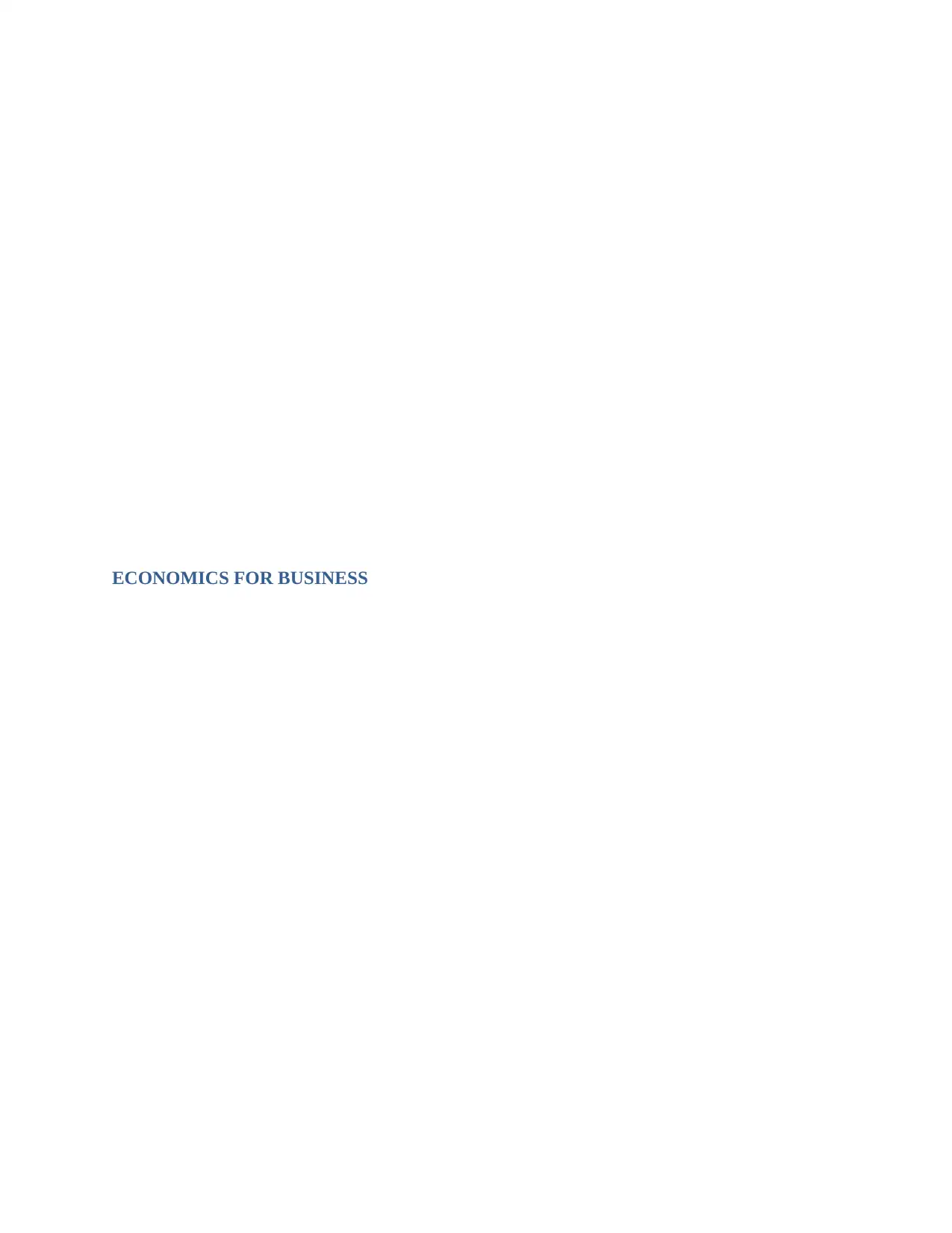
ECONOMICS FOR BUSINESS
Paraphrase This Document
Need a fresh take? Get an instant paraphrase of this document with our AI Paraphraser
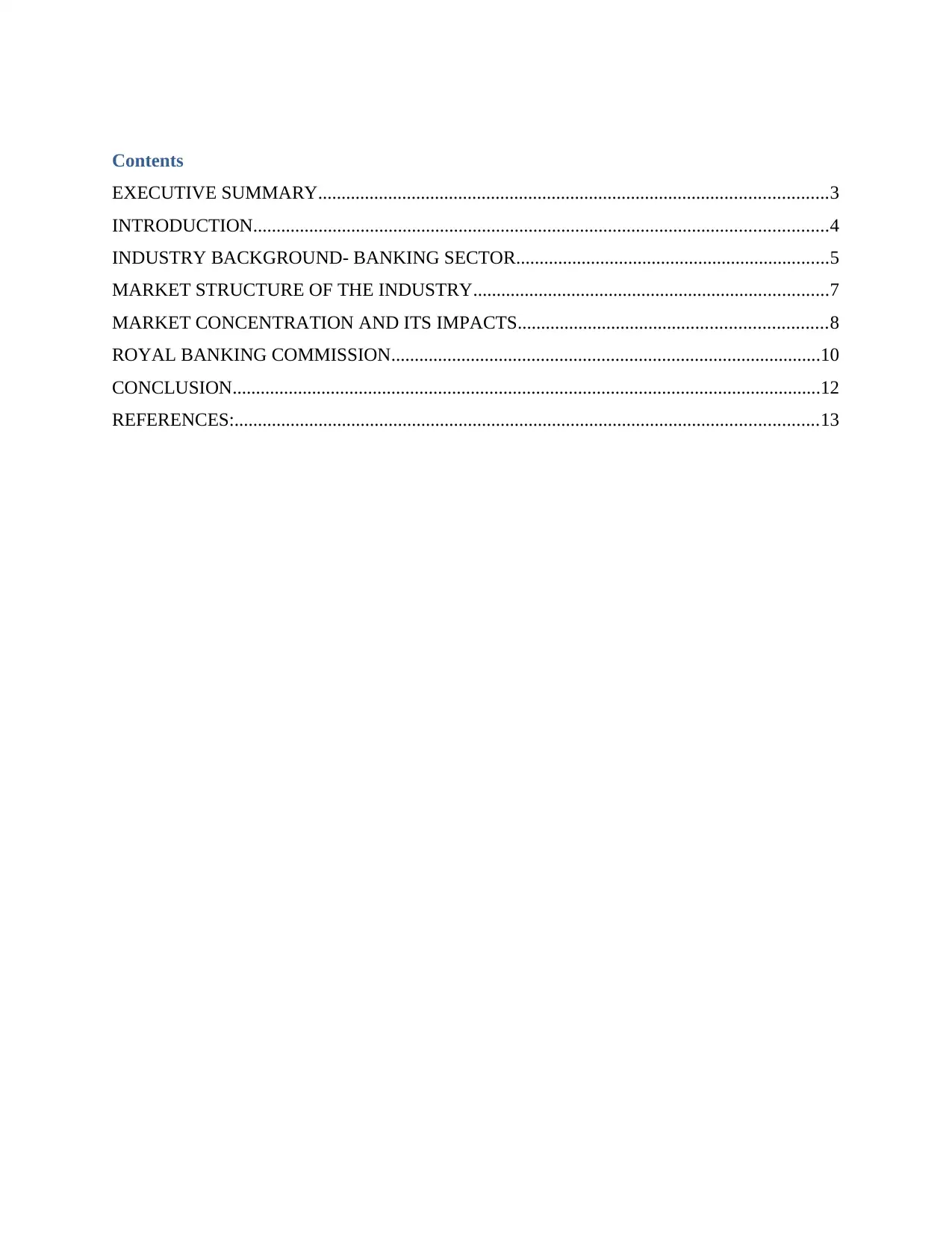
Contents
EXECUTIVE SUMMARY.............................................................................................................3
INTRODUCTION...........................................................................................................................4
INDUSTRY BACKGROUND- BANKING SECTOR...................................................................5
MARKET STRUCTURE OF THE INDUSTRY............................................................................7
MARKET CONCENTRATION AND ITS IMPACTS..................................................................8
ROYAL BANKING COMMISSION............................................................................................10
CONCLUSION..............................................................................................................................12
REFERENCES:.............................................................................................................................13
EXECUTIVE SUMMARY.............................................................................................................3
INTRODUCTION...........................................................................................................................4
INDUSTRY BACKGROUND- BANKING SECTOR...................................................................5
MARKET STRUCTURE OF THE INDUSTRY............................................................................7
MARKET CONCENTRATION AND ITS IMPACTS..................................................................8
ROYAL BANKING COMMISSION............................................................................................10
CONCLUSION..............................................................................................................................12
REFERENCES:.............................................................................................................................13
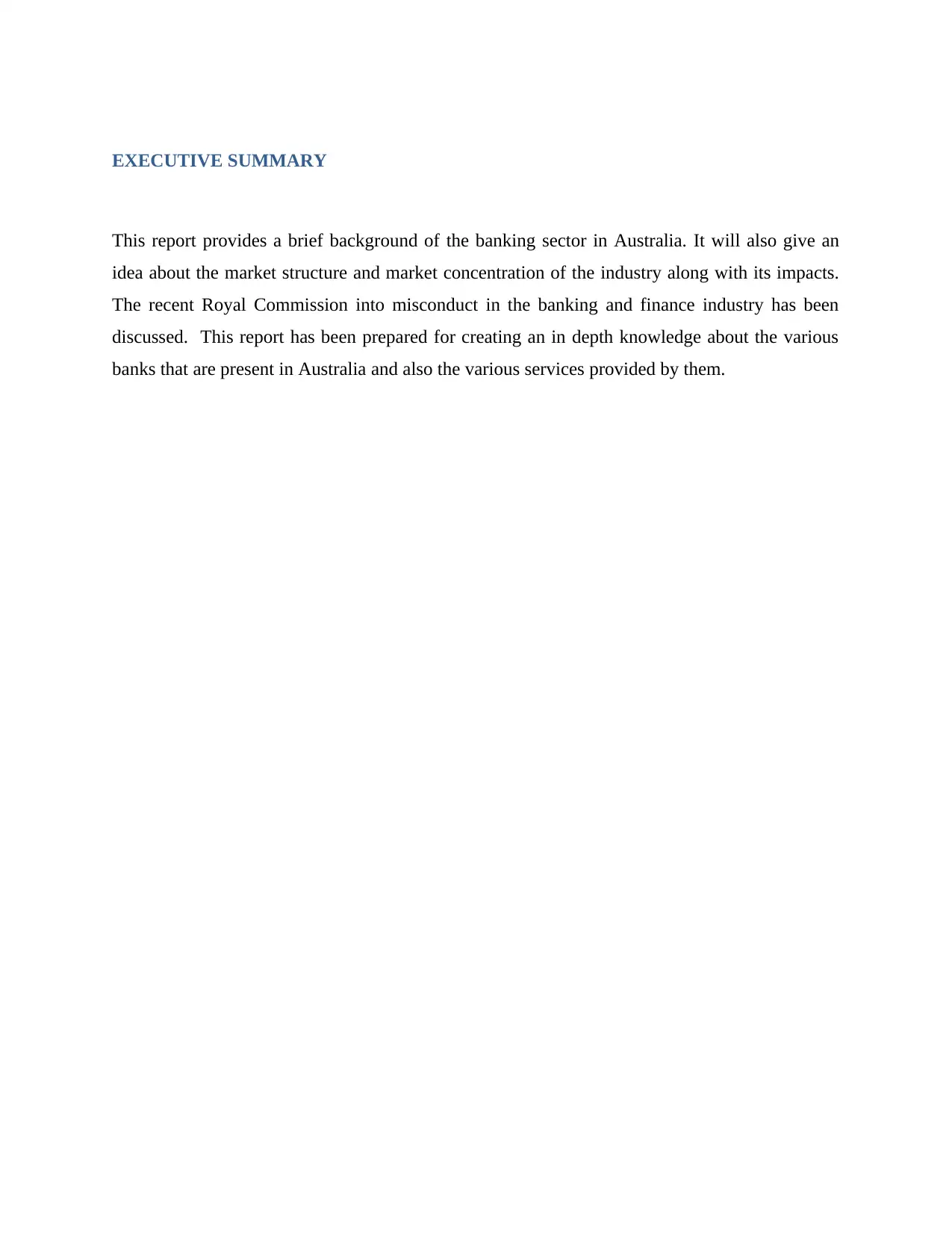
EXECUTIVE SUMMARY
This report provides a brief background of the banking sector in Australia. It will also give an
idea about the market structure and market concentration of the industry along with its impacts.
The recent Royal Commission into misconduct in the banking and finance industry has been
discussed. This report has been prepared for creating an in depth knowledge about the various
banks that are present in Australia and also the various services provided by them.
This report provides a brief background of the banking sector in Australia. It will also give an
idea about the market structure and market concentration of the industry along with its impacts.
The recent Royal Commission into misconduct in the banking and finance industry has been
discussed. This report has been prepared for creating an in depth knowledge about the various
banks that are present in Australia and also the various services provided by them.
⊘ This is a preview!⊘
Do you want full access?
Subscribe today to unlock all pages.

Trusted by 1+ million students worldwide
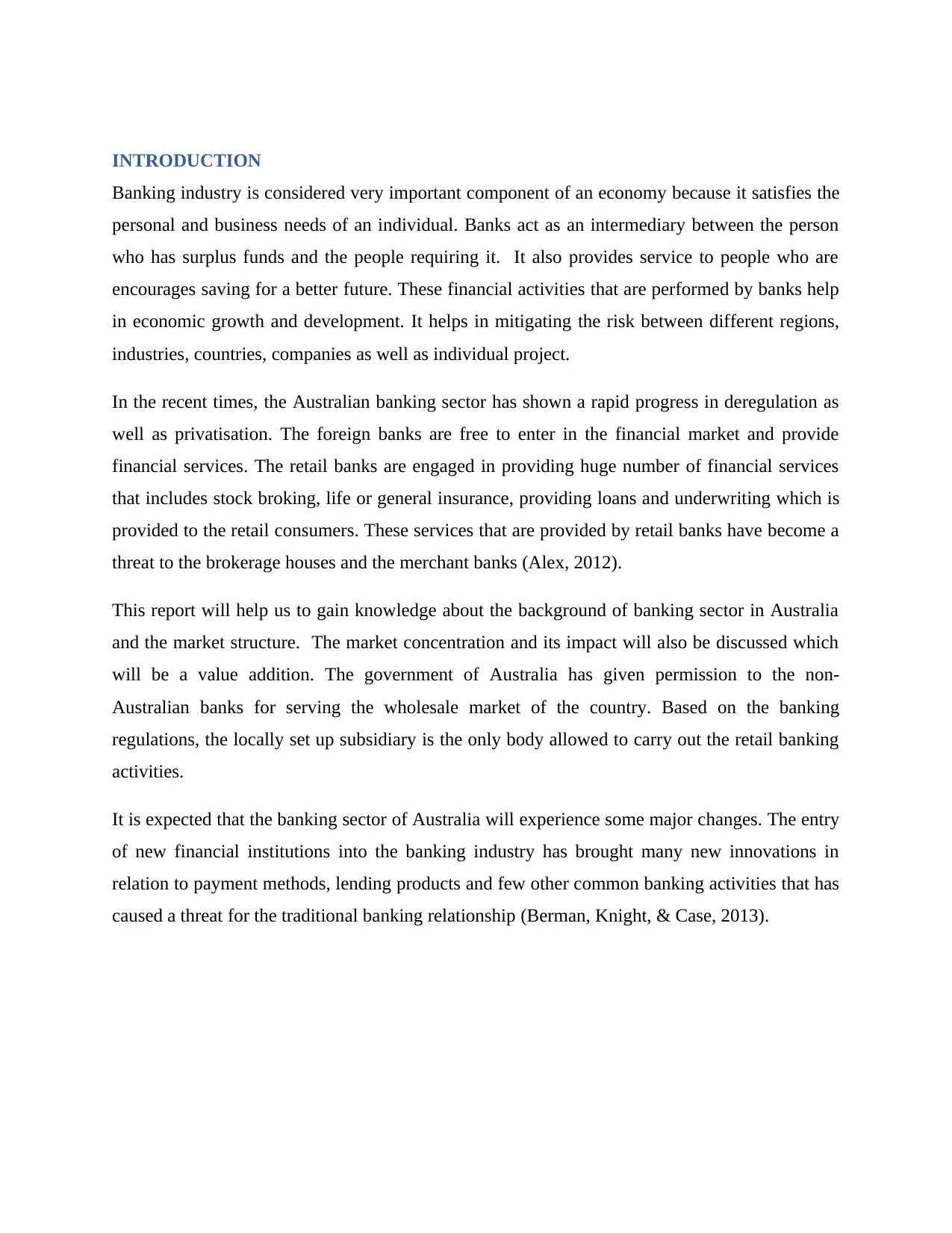
INTRODUCTION
Banking industry is considered very important component of an economy because it satisfies the
personal and business needs of an individual. Banks act as an intermediary between the person
who has surplus funds and the people requiring it. It also provides service to people who are
encourages saving for a better future. These financial activities that are performed by banks help
in economic growth and development. It helps in mitigating the risk between different regions,
industries, countries, companies as well as individual project.
In the recent times, the Australian banking sector has shown a rapid progress in deregulation as
well as privatisation. The foreign banks are free to enter in the financial market and provide
financial services. The retail banks are engaged in providing huge number of financial services
that includes stock broking, life or general insurance, providing loans and underwriting which is
provided to the retail consumers. These services that are provided by retail banks have become a
threat to the brokerage houses and the merchant banks (Alex, 2012).
This report will help us to gain knowledge about the background of banking sector in Australia
and the market structure. The market concentration and its impact will also be discussed which
will be a value addition. The government of Australia has given permission to the non-
Australian banks for serving the wholesale market of the country. Based on the banking
regulations, the locally set up subsidiary is the only body allowed to carry out the retail banking
activities.
It is expected that the banking sector of Australia will experience some major changes. The entry
of new financial institutions into the banking industry has brought many new innovations in
relation to payment methods, lending products and few other common banking activities that has
caused a threat for the traditional banking relationship (Berman, Knight, & Case, 2013).
Banking industry is considered very important component of an economy because it satisfies the
personal and business needs of an individual. Banks act as an intermediary between the person
who has surplus funds and the people requiring it. It also provides service to people who are
encourages saving for a better future. These financial activities that are performed by banks help
in economic growth and development. It helps in mitigating the risk between different regions,
industries, countries, companies as well as individual project.
In the recent times, the Australian banking sector has shown a rapid progress in deregulation as
well as privatisation. The foreign banks are free to enter in the financial market and provide
financial services. The retail banks are engaged in providing huge number of financial services
that includes stock broking, life or general insurance, providing loans and underwriting which is
provided to the retail consumers. These services that are provided by retail banks have become a
threat to the brokerage houses and the merchant banks (Alex, 2012).
This report will help us to gain knowledge about the background of banking sector in Australia
and the market structure. The market concentration and its impact will also be discussed which
will be a value addition. The government of Australia has given permission to the non-
Australian banks for serving the wholesale market of the country. Based on the banking
regulations, the locally set up subsidiary is the only body allowed to carry out the retail banking
activities.
It is expected that the banking sector of Australia will experience some major changes. The entry
of new financial institutions into the banking industry has brought many new innovations in
relation to payment methods, lending products and few other common banking activities that has
caused a threat for the traditional banking relationship (Berman, Knight, & Case, 2013).
Paraphrase This Document
Need a fresh take? Get an instant paraphrase of this document with our AI Paraphraser
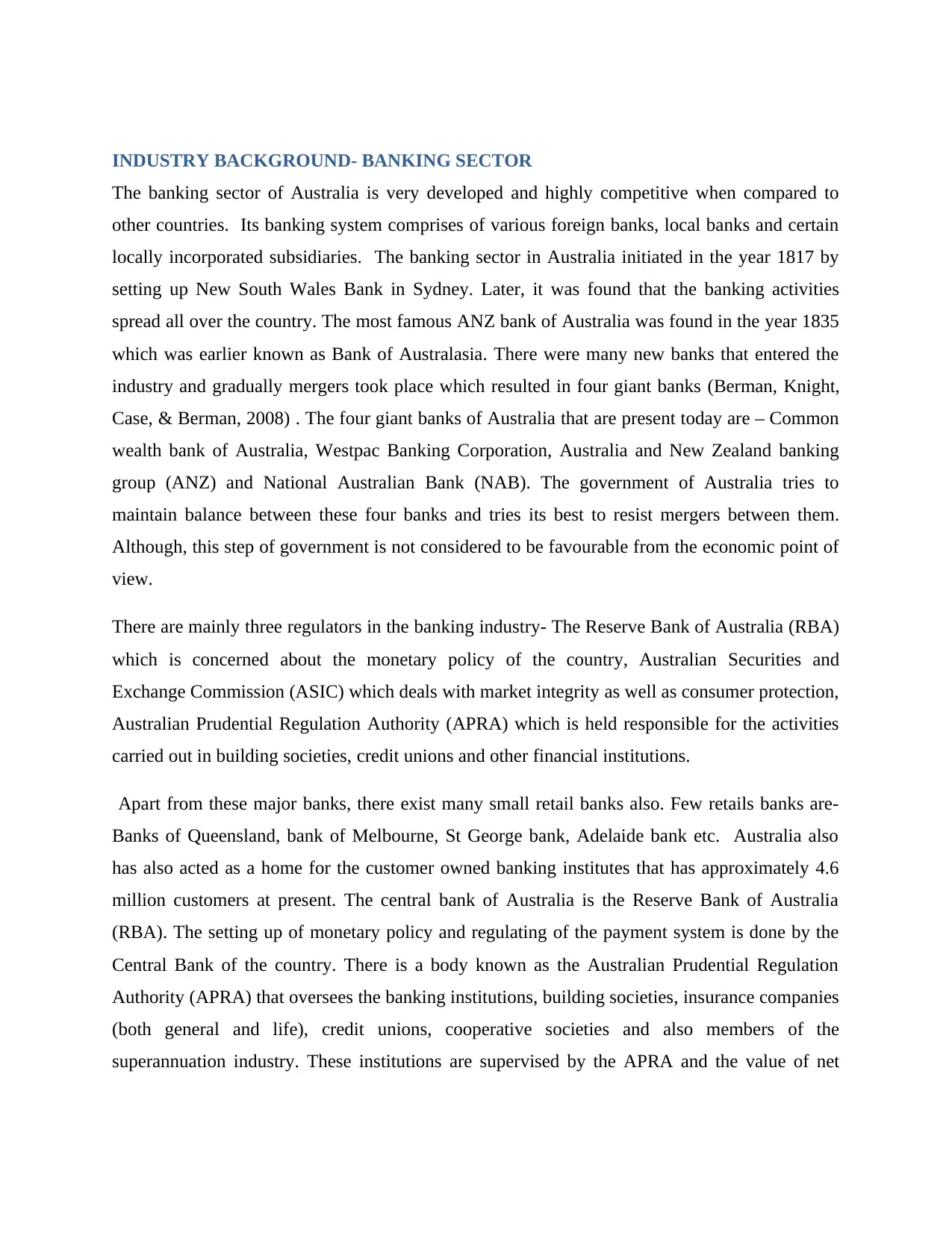
INDUSTRY BACKGROUND- BANKING SECTOR
The banking sector of Australia is very developed and highly competitive when compared to
other countries. Its banking system comprises of various foreign banks, local banks and certain
locally incorporated subsidiaries. The banking sector in Australia initiated in the year 1817 by
setting up New South Wales Bank in Sydney. Later, it was found that the banking activities
spread all over the country. The most famous ANZ bank of Australia was found in the year 1835
which was earlier known as Bank of Australasia. There were many new banks that entered the
industry and gradually mergers took place which resulted in four giant banks (Berman, Knight,
Case, & Berman, 2008) . The four giant banks of Australia that are present today are – Common
wealth bank of Australia, Westpac Banking Corporation, Australia and New Zealand banking
group (ANZ) and National Australian Bank (NAB). The government of Australia tries to
maintain balance between these four banks and tries its best to resist mergers between them.
Although, this step of government is not considered to be favourable from the economic point of
view.
There are mainly three regulators in the banking industry- The Reserve Bank of Australia (RBA)
which is concerned about the monetary policy of the country, Australian Securities and
Exchange Commission (ASIC) which deals with market integrity as well as consumer protection,
Australian Prudential Regulation Authority (APRA) which is held responsible for the activities
carried out in building societies, credit unions and other financial institutions.
Apart from these major banks, there exist many small retail banks also. Few retails banks are-
Banks of Queensland, bank of Melbourne, St George bank, Adelaide bank etc. Australia also
has also acted as a home for the customer owned banking institutes that has approximately 4.6
million customers at present. The central bank of Australia is the Reserve Bank of Australia
(RBA). The setting up of monetary policy and regulating of the payment system is done by the
Central Bank of the country. There is a body known as the Australian Prudential Regulation
Authority (APRA) that oversees the banking institutions, building societies, insurance companies
(both general and life), credit unions, cooperative societies and also members of the
superannuation industry. These institutions are supervised by the APRA and the value of net
The banking sector of Australia is very developed and highly competitive when compared to
other countries. Its banking system comprises of various foreign banks, local banks and certain
locally incorporated subsidiaries. The banking sector in Australia initiated in the year 1817 by
setting up New South Wales Bank in Sydney. Later, it was found that the banking activities
spread all over the country. The most famous ANZ bank of Australia was found in the year 1835
which was earlier known as Bank of Australasia. There were many new banks that entered the
industry and gradually mergers took place which resulted in four giant banks (Berman, Knight,
Case, & Berman, 2008) . The four giant banks of Australia that are present today are – Common
wealth bank of Australia, Westpac Banking Corporation, Australia and New Zealand banking
group (ANZ) and National Australian Bank (NAB). The government of Australia tries to
maintain balance between these four banks and tries its best to resist mergers between them.
Although, this step of government is not considered to be favourable from the economic point of
view.
There are mainly three regulators in the banking industry- The Reserve Bank of Australia (RBA)
which is concerned about the monetary policy of the country, Australian Securities and
Exchange Commission (ASIC) which deals with market integrity as well as consumer protection,
Australian Prudential Regulation Authority (APRA) which is held responsible for the activities
carried out in building societies, credit unions and other financial institutions.
Apart from these major banks, there exist many small retail banks also. Few retails banks are-
Banks of Queensland, bank of Melbourne, St George bank, Adelaide bank etc. Australia also
has also acted as a home for the customer owned banking institutes that has approximately 4.6
million customers at present. The central bank of Australia is the Reserve Bank of Australia
(RBA). The setting up of monetary policy and regulating of the payment system is done by the
Central Bank of the country. There is a body known as the Australian Prudential Regulation
Authority (APRA) that oversees the banking institutions, building societies, insurance companies
(both general and life), credit unions, cooperative societies and also members of the
superannuation industry. These institutions are supervised by the APRA and the value of net
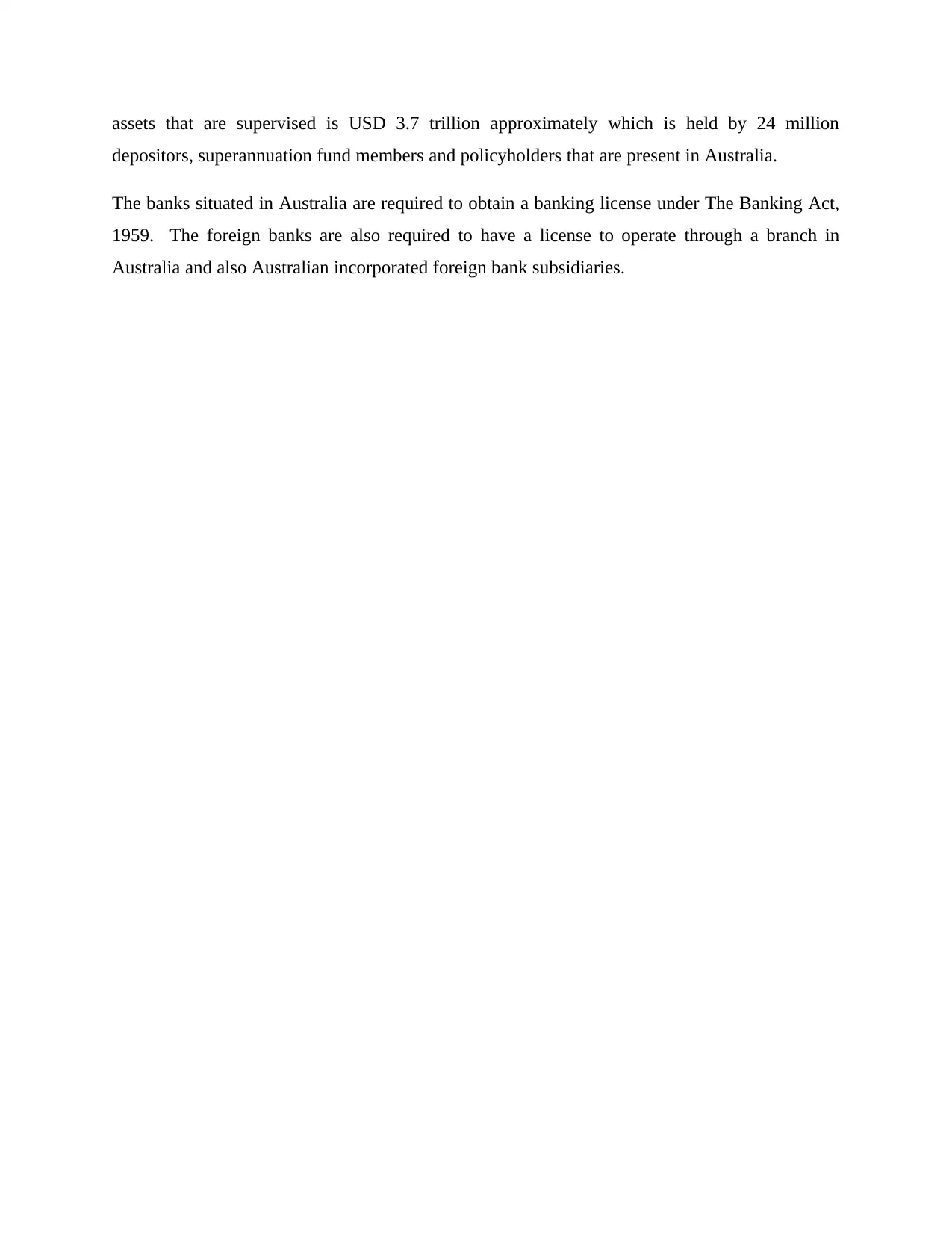
assets that are supervised is USD 3.7 trillion approximately which is held by 24 million
depositors, superannuation fund members and policyholders that are present in Australia.
The banks situated in Australia are required to obtain a banking license under The Banking Act,
1959. The foreign banks are also required to have a license to operate through a branch in
Australia and also Australian incorporated foreign bank subsidiaries.
depositors, superannuation fund members and policyholders that are present in Australia.
The banks situated in Australia are required to obtain a banking license under The Banking Act,
1959. The foreign banks are also required to have a license to operate through a branch in
Australia and also Australian incorporated foreign bank subsidiaries.
⊘ This is a preview!⊘
Do you want full access?
Subscribe today to unlock all pages.

Trusted by 1+ million students worldwide
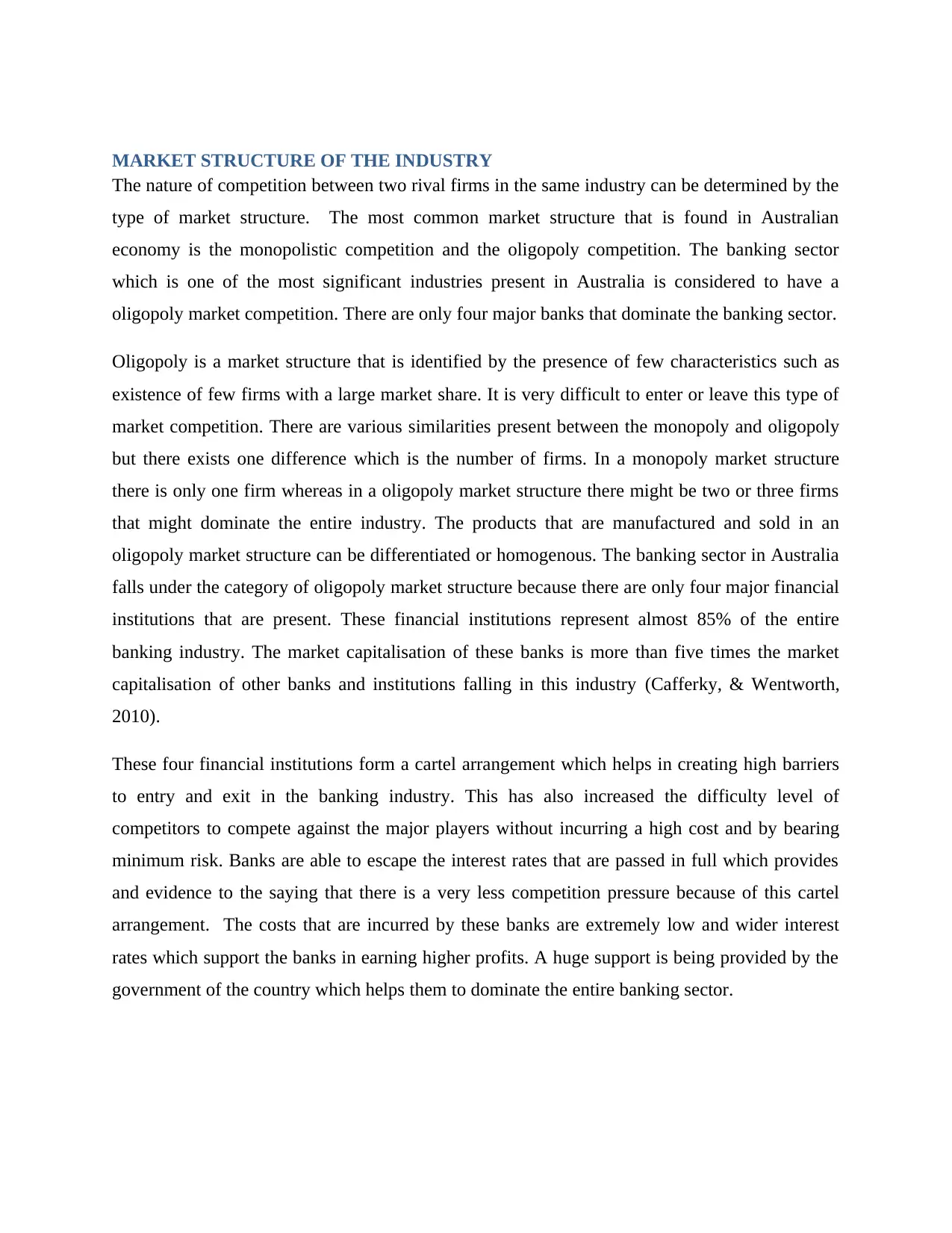
MARKET STRUCTURE OF THE INDUSTRY
The nature of competition between two rival firms in the same industry can be determined by the
type of market structure. The most common market structure that is found in Australian
economy is the monopolistic competition and the oligopoly competition. The banking sector
which is one of the most significant industries present in Australia is considered to have a
oligopoly market competition. There are only four major banks that dominate the banking sector.
Oligopoly is a market structure that is identified by the presence of few characteristics such as
existence of few firms with a large market share. It is very difficult to enter or leave this type of
market competition. There are various similarities present between the monopoly and oligopoly
but there exists one difference which is the number of firms. In a monopoly market structure
there is only one firm whereas in a oligopoly market structure there might be two or three firms
that might dominate the entire industry. The products that are manufactured and sold in an
oligopoly market structure can be differentiated or homogenous. The banking sector in Australia
falls under the category of oligopoly market structure because there are only four major financial
institutions that are present. These financial institutions represent almost 85% of the entire
banking industry. The market capitalisation of these banks is more than five times the market
capitalisation of other banks and institutions falling in this industry (Cafferky, & Wentworth,
2010).
These four financial institutions form a cartel arrangement which helps in creating high barriers
to entry and exit in the banking industry. This has also increased the difficulty level of
competitors to compete against the major players without incurring a high cost and by bearing
minimum risk. Banks are able to escape the interest rates that are passed in full which provides
and evidence to the saying that there is a very less competition pressure because of this cartel
arrangement. The costs that are incurred by these banks are extremely low and wider interest
rates which support the banks in earning higher profits. A huge support is being provided by the
government of the country which helps them to dominate the entire banking sector.
The nature of competition between two rival firms in the same industry can be determined by the
type of market structure. The most common market structure that is found in Australian
economy is the monopolistic competition and the oligopoly competition. The banking sector
which is one of the most significant industries present in Australia is considered to have a
oligopoly market competition. There are only four major banks that dominate the banking sector.
Oligopoly is a market structure that is identified by the presence of few characteristics such as
existence of few firms with a large market share. It is very difficult to enter or leave this type of
market competition. There are various similarities present between the monopoly and oligopoly
but there exists one difference which is the number of firms. In a monopoly market structure
there is only one firm whereas in a oligopoly market structure there might be two or three firms
that might dominate the entire industry. The products that are manufactured and sold in an
oligopoly market structure can be differentiated or homogenous. The banking sector in Australia
falls under the category of oligopoly market structure because there are only four major financial
institutions that are present. These financial institutions represent almost 85% of the entire
banking industry. The market capitalisation of these banks is more than five times the market
capitalisation of other banks and institutions falling in this industry (Cafferky, & Wentworth,
2010).
These four financial institutions form a cartel arrangement which helps in creating high barriers
to entry and exit in the banking industry. This has also increased the difficulty level of
competitors to compete against the major players without incurring a high cost and by bearing
minimum risk. Banks are able to escape the interest rates that are passed in full which provides
and evidence to the saying that there is a very less competition pressure because of this cartel
arrangement. The costs that are incurred by these banks are extremely low and wider interest
rates which support the banks in earning higher profits. A huge support is being provided by the
government of the country which helps them to dominate the entire banking sector.
Paraphrase This Document
Need a fresh take? Get an instant paraphrase of this document with our AI Paraphraser
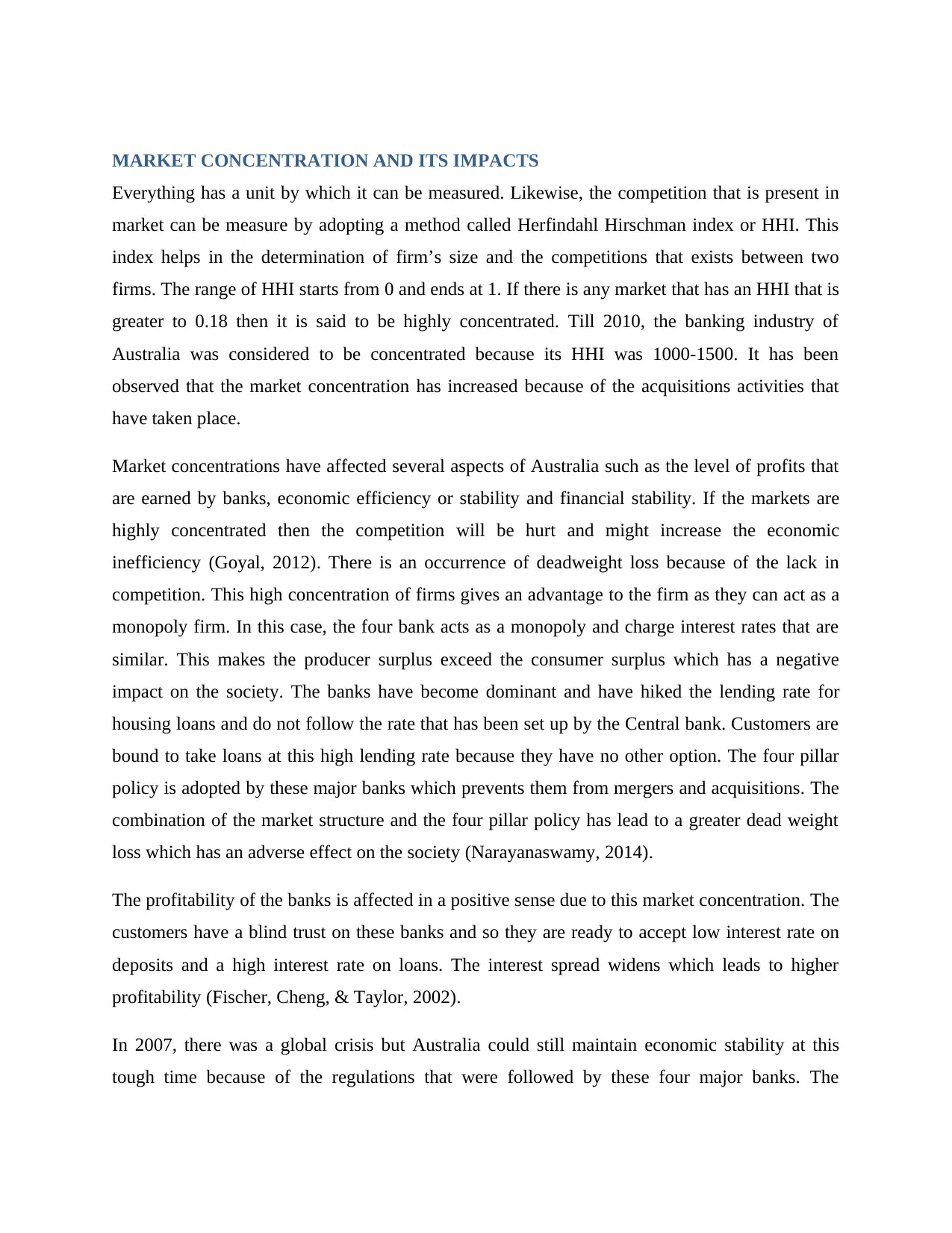
MARKET CONCENTRATION AND ITS IMPACTS
Everything has a unit by which it can be measured. Likewise, the competition that is present in
market can be measure by adopting a method called Herfindahl Hirschman index or HHI. This
index helps in the determination of firm’s size and the competitions that exists between two
firms. The range of HHI starts from 0 and ends at 1. If there is any market that has an HHI that is
greater to 0.18 then it is said to be highly concentrated. Till 2010, the banking industry of
Australia was considered to be concentrated because its HHI was 1000-1500. It has been
observed that the market concentration has increased because of the acquisitions activities that
have taken place.
Market concentrations have affected several aspects of Australia such as the level of profits that
are earned by banks, economic efficiency or stability and financial stability. If the markets are
highly concentrated then the competition will be hurt and might increase the economic
inefficiency (Goyal, 2012). There is an occurrence of deadweight loss because of the lack in
competition. This high concentration of firms gives an advantage to the firm as they can act as a
monopoly firm. In this case, the four bank acts as a monopoly and charge interest rates that are
similar. This makes the producer surplus exceed the consumer surplus which has a negative
impact on the society. The banks have become dominant and have hiked the lending rate for
housing loans and do not follow the rate that has been set up by the Central bank. Customers are
bound to take loans at this high lending rate because they have no other option. The four pillar
policy is adopted by these major banks which prevents them from mergers and acquisitions. The
combination of the market structure and the four pillar policy has lead to a greater dead weight
loss which has an adverse effect on the society (Narayanaswamy, 2014).
The profitability of the banks is affected in a positive sense due to this market concentration. The
customers have a blind trust on these banks and so they are ready to accept low interest rate on
deposits and a high interest rate on loans. The interest spread widens which leads to higher
profitability (Fischer, Cheng, & Taylor, 2002).
In 2007, there was a global crisis but Australia could still maintain economic stability at this
tough time because of the regulations that were followed by these four major banks. The
Everything has a unit by which it can be measured. Likewise, the competition that is present in
market can be measure by adopting a method called Herfindahl Hirschman index or HHI. This
index helps in the determination of firm’s size and the competitions that exists between two
firms. The range of HHI starts from 0 and ends at 1. If there is any market that has an HHI that is
greater to 0.18 then it is said to be highly concentrated. Till 2010, the banking industry of
Australia was considered to be concentrated because its HHI was 1000-1500. It has been
observed that the market concentration has increased because of the acquisitions activities that
have taken place.
Market concentrations have affected several aspects of Australia such as the level of profits that
are earned by banks, economic efficiency or stability and financial stability. If the markets are
highly concentrated then the competition will be hurt and might increase the economic
inefficiency (Goyal, 2012). There is an occurrence of deadweight loss because of the lack in
competition. This high concentration of firms gives an advantage to the firm as they can act as a
monopoly firm. In this case, the four bank acts as a monopoly and charge interest rates that are
similar. This makes the producer surplus exceed the consumer surplus which has a negative
impact on the society. The banks have become dominant and have hiked the lending rate for
housing loans and do not follow the rate that has been set up by the Central bank. Customers are
bound to take loans at this high lending rate because they have no other option. The four pillar
policy is adopted by these major banks which prevents them from mergers and acquisitions. The
combination of the market structure and the four pillar policy has lead to a greater dead weight
loss which has an adverse effect on the society (Narayanaswamy, 2014).
The profitability of the banks is affected in a positive sense due to this market concentration. The
customers have a blind trust on these banks and so they are ready to accept low interest rate on
deposits and a high interest rate on loans. The interest spread widens which leads to higher
profitability (Fischer, Cheng, & Taylor, 2002).
In 2007, there was a global crisis but Australia could still maintain economic stability at this
tough time because of the regulations that were followed by these four major banks. The
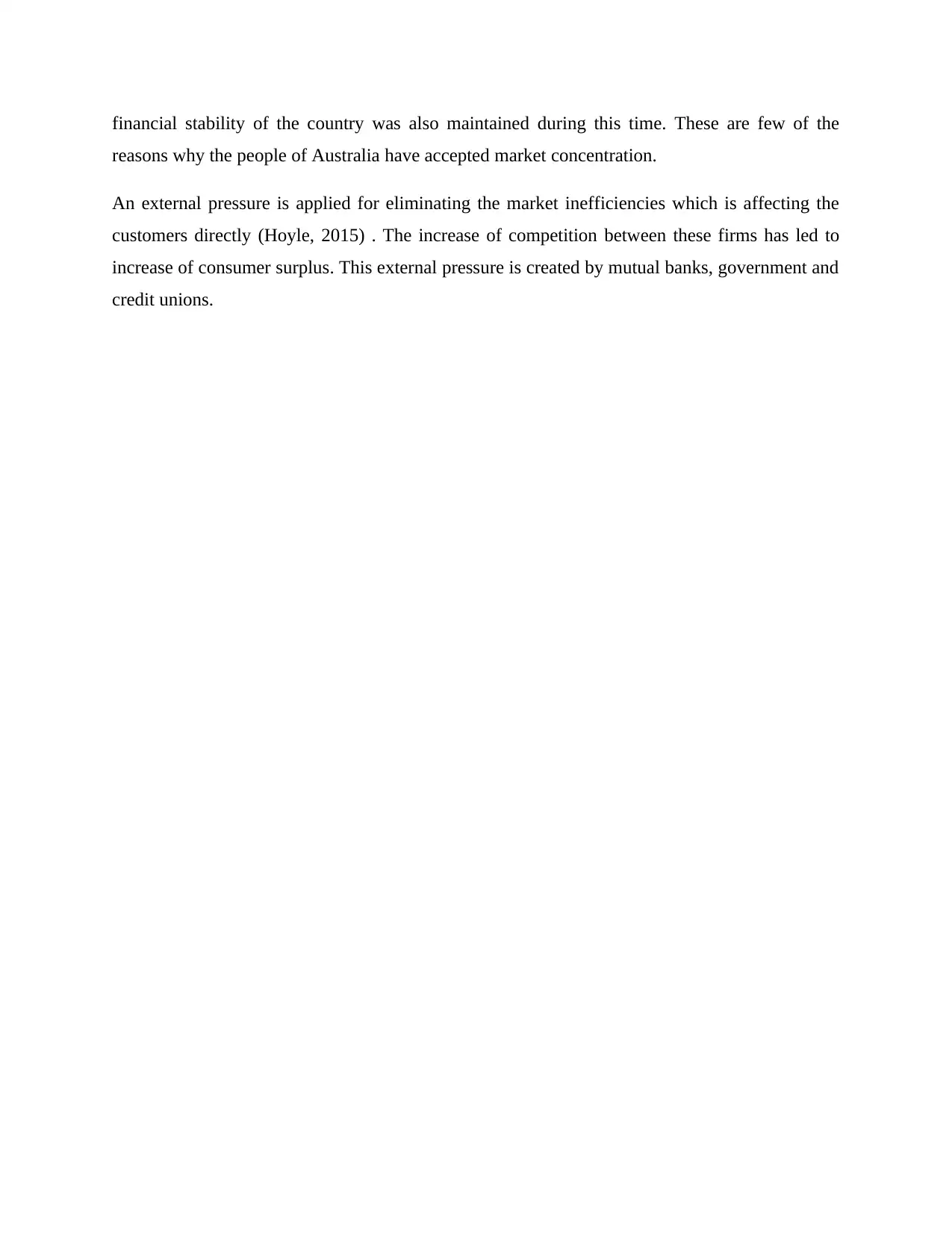
financial stability of the country was also maintained during this time. These are few of the
reasons why the people of Australia have accepted market concentration.
An external pressure is applied for eliminating the market inefficiencies which is affecting the
customers directly (Hoyle, 2015) . The increase of competition between these firms has led to
increase of consumer surplus. This external pressure is created by mutual banks, government and
credit unions.
reasons why the people of Australia have accepted market concentration.
An external pressure is applied for eliminating the market inefficiencies which is affecting the
customers directly (Hoyle, 2015) . The increase of competition between these firms has led to
increase of consumer surplus. This external pressure is created by mutual banks, government and
credit unions.
⊘ This is a preview!⊘
Do you want full access?
Subscribe today to unlock all pages.

Trusted by 1+ million students worldwide
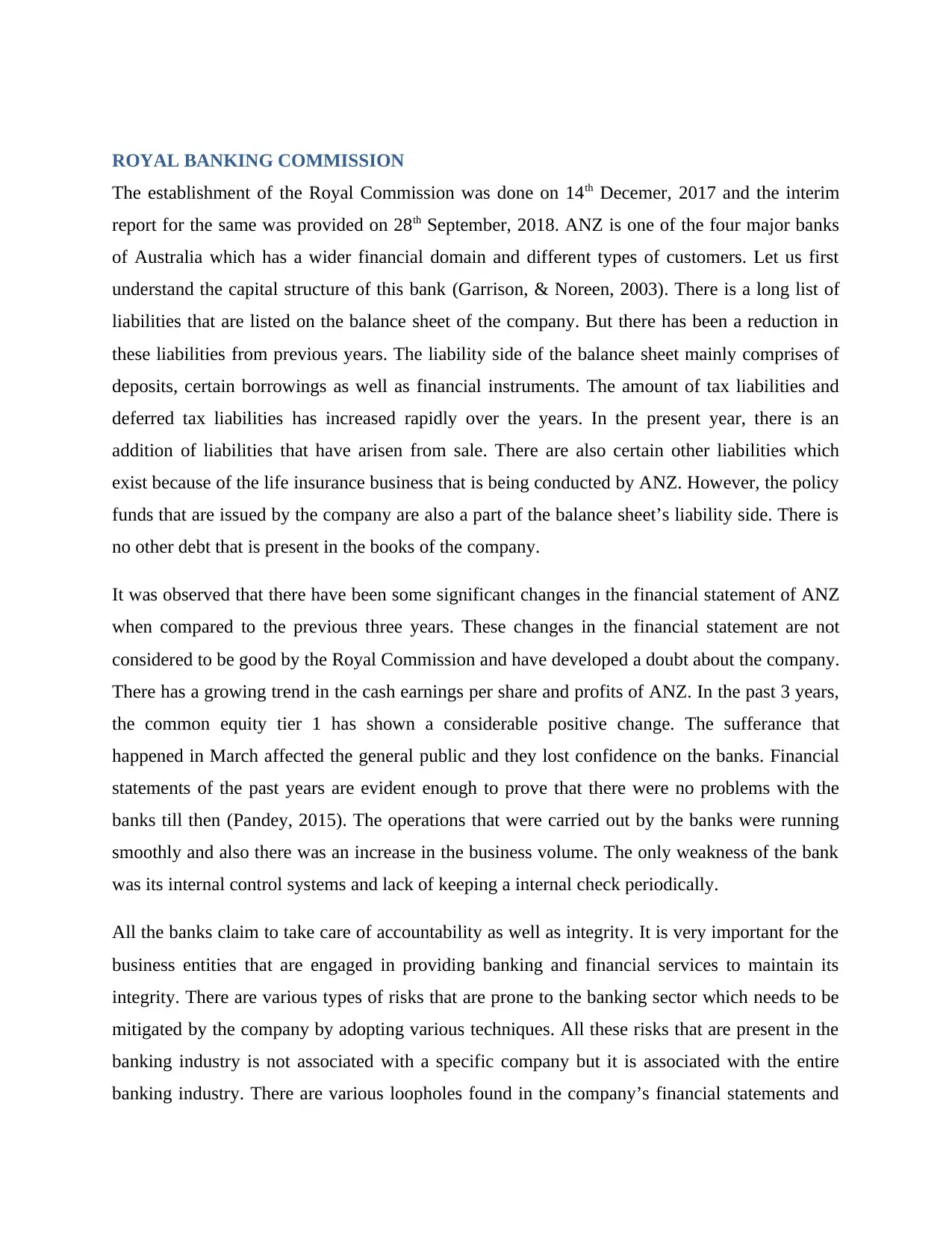
ROYAL BANKING COMMISSION
The establishment of the Royal Commission was done on 14th Decemer, 2017 and the interim
report for the same was provided on 28th September, 2018. ANZ is one of the four major banks
of Australia which has a wider financial domain and different types of customers. Let us first
understand the capital structure of this bank (Garrison, & Noreen, 2003). There is a long list of
liabilities that are listed on the balance sheet of the company. But there has been a reduction in
these liabilities from previous years. The liability side of the balance sheet mainly comprises of
deposits, certain borrowings as well as financial instruments. The amount of tax liabilities and
deferred tax liabilities has increased rapidly over the years. In the present year, there is an
addition of liabilities that have arisen from sale. There are also certain other liabilities which
exist because of the life insurance business that is being conducted by ANZ. However, the policy
funds that are issued by the company are also a part of the balance sheet’s liability side. There is
no other debt that is present in the books of the company.
It was observed that there have been some significant changes in the financial statement of ANZ
when compared to the previous three years. These changes in the financial statement are not
considered to be good by the Royal Commission and have developed a doubt about the company.
There has a growing trend in the cash earnings per share and profits of ANZ. In the past 3 years,
the common equity tier 1 has shown a considerable positive change. The sufferance that
happened in March affected the general public and they lost confidence on the banks. Financial
statements of the past years are evident enough to prove that there were no problems with the
banks till then (Pandey, 2015). The operations that were carried out by the banks were running
smoothly and also there was an increase in the business volume. The only weakness of the bank
was its internal control systems and lack of keeping a internal check periodically.
All the banks claim to take care of accountability as well as integrity. It is very important for the
business entities that are engaged in providing banking and financial services to maintain its
integrity. There are various types of risks that are prone to the banking sector which needs to be
mitigated by the company by adopting various techniques. All these risks that are present in the
banking industry is not associated with a specific company but it is associated with the entire
banking industry. There are various loopholes found in the company’s financial statements and
The establishment of the Royal Commission was done on 14th Decemer, 2017 and the interim
report for the same was provided on 28th September, 2018. ANZ is one of the four major banks
of Australia which has a wider financial domain and different types of customers. Let us first
understand the capital structure of this bank (Garrison, & Noreen, 2003). There is a long list of
liabilities that are listed on the balance sheet of the company. But there has been a reduction in
these liabilities from previous years. The liability side of the balance sheet mainly comprises of
deposits, certain borrowings as well as financial instruments. The amount of tax liabilities and
deferred tax liabilities has increased rapidly over the years. In the present year, there is an
addition of liabilities that have arisen from sale. There are also certain other liabilities which
exist because of the life insurance business that is being conducted by ANZ. However, the policy
funds that are issued by the company are also a part of the balance sheet’s liability side. There is
no other debt that is present in the books of the company.
It was observed that there have been some significant changes in the financial statement of ANZ
when compared to the previous three years. These changes in the financial statement are not
considered to be good by the Royal Commission and have developed a doubt about the company.
There has a growing trend in the cash earnings per share and profits of ANZ. In the past 3 years,
the common equity tier 1 has shown a considerable positive change. The sufferance that
happened in March affected the general public and they lost confidence on the banks. Financial
statements of the past years are evident enough to prove that there were no problems with the
banks till then (Pandey, 2015). The operations that were carried out by the banks were running
smoothly and also there was an increase in the business volume. The only weakness of the bank
was its internal control systems and lack of keeping a internal check periodically.
All the banks claim to take care of accountability as well as integrity. It is very important for the
business entities that are engaged in providing banking and financial services to maintain its
integrity. There are various types of risks that are prone to the banking sector which needs to be
mitigated by the company by adopting various techniques. All these risks that are present in the
banking industry is not associated with a specific company but it is associated with the entire
banking industry. There are various loopholes found in the company’s financial statements and
Paraphrase This Document
Need a fresh take? Get an instant paraphrase of this document with our AI Paraphraser
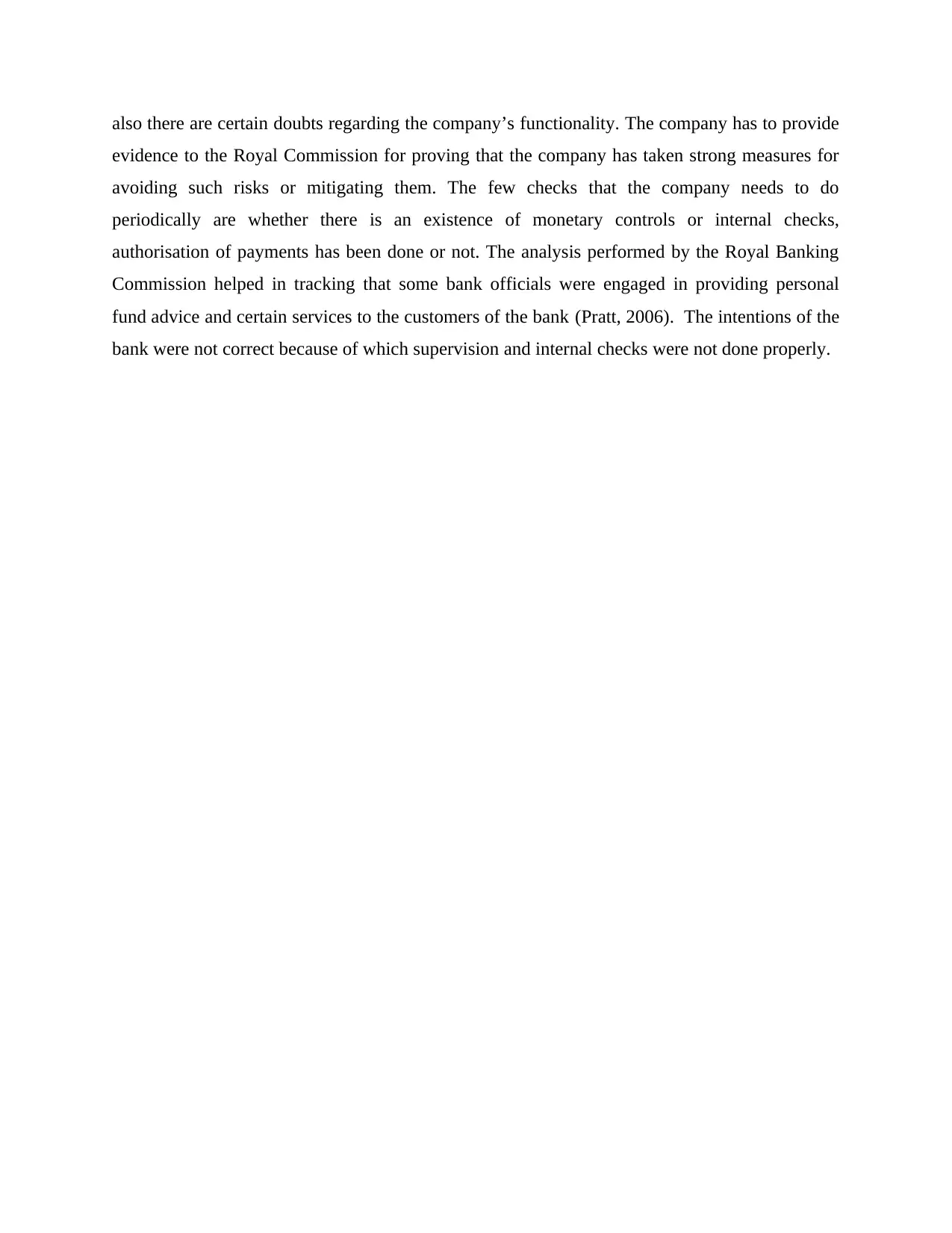
also there are certain doubts regarding the company’s functionality. The company has to provide
evidence to the Royal Commission for proving that the company has taken strong measures for
avoiding such risks or mitigating them. The few checks that the company needs to do
periodically are whether there is an existence of monetary controls or internal checks,
authorisation of payments has been done or not. The analysis performed by the Royal Banking
Commission helped in tracking that some bank officials were engaged in providing personal
fund advice and certain services to the customers of the bank (Pratt, 2006). The intentions of the
bank were not correct because of which supervision and internal checks were not done properly.
evidence to the Royal Commission for proving that the company has taken strong measures for
avoiding such risks or mitigating them. The few checks that the company needs to do
periodically are whether there is an existence of monetary controls or internal checks,
authorisation of payments has been done or not. The analysis performed by the Royal Banking
Commission helped in tracking that some bank officials were engaged in providing personal
fund advice and certain services to the customers of the bank (Pratt, 2006). The intentions of the
bank were not correct because of which supervision and internal checks were not done properly.
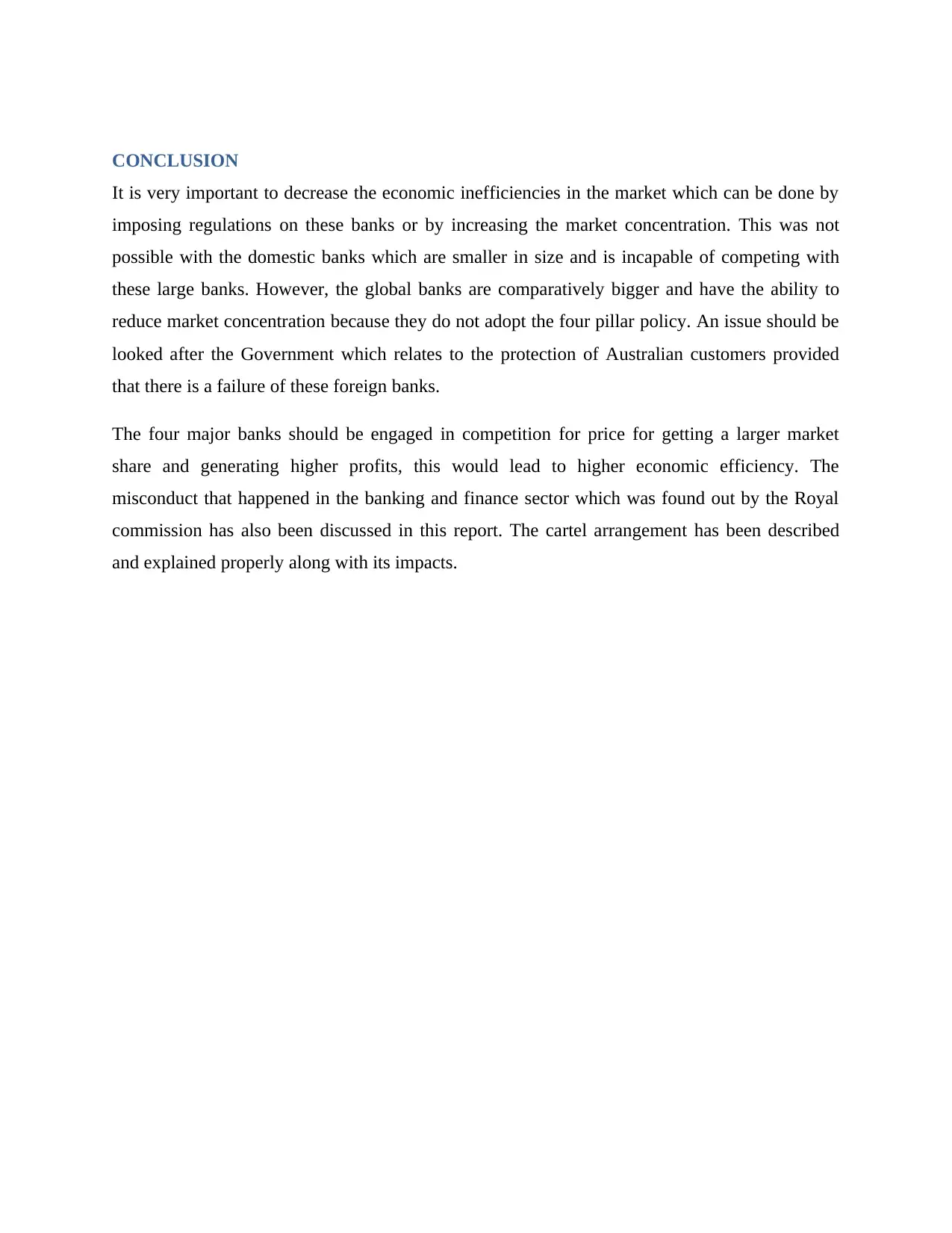
CONCLUSION
It is very important to decrease the economic inefficiencies in the market which can be done by
imposing regulations on these banks or by increasing the market concentration. This was not
possible with the domestic banks which are smaller in size and is incapable of competing with
these large banks. However, the global banks are comparatively bigger and have the ability to
reduce market concentration because they do not adopt the four pillar policy. An issue should be
looked after the Government which relates to the protection of Australian customers provided
that there is a failure of these foreign banks.
The four major banks should be engaged in competition for price for getting a larger market
share and generating higher profits, this would lead to higher economic efficiency. The
misconduct that happened in the banking and finance sector which was found out by the Royal
commission has also been discussed in this report. The cartel arrangement has been described
and explained properly along with its impacts.
It is very important to decrease the economic inefficiencies in the market which can be done by
imposing regulations on these banks or by increasing the market concentration. This was not
possible with the domestic banks which are smaller in size and is incapable of competing with
these large banks. However, the global banks are comparatively bigger and have the ability to
reduce market concentration because they do not adopt the four pillar policy. An issue should be
looked after the Government which relates to the protection of Australian customers provided
that there is a failure of these foreign banks.
The four major banks should be engaged in competition for price for getting a larger market
share and generating higher profits, this would lead to higher economic efficiency. The
misconduct that happened in the banking and finance sector which was found out by the Royal
commission has also been discussed in this report. The cartel arrangement has been described
and explained properly along with its impacts.
⊘ This is a preview!⊘
Do you want full access?
Subscribe today to unlock all pages.

Trusted by 1+ million students worldwide
1 out of 14
Related Documents
Your All-in-One AI-Powered Toolkit for Academic Success.
+13062052269
info@desklib.com
Available 24*7 on WhatsApp / Email
![[object Object]](/_next/static/media/star-bottom.7253800d.svg)
Unlock your academic potential
Copyright © 2020–2025 A2Z Services. All Rights Reserved. Developed and managed by ZUCOL.





